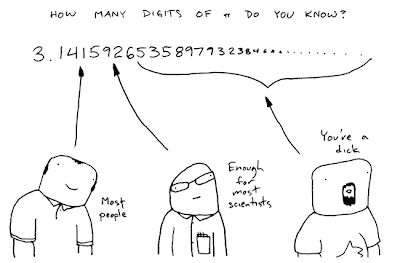...that is, "nothing without a name."
1We name things in order to be able to speak precisely. Often, names themselves tell as a little bit about the item in question. Sometimes, names are just names. Sometimes, the meta-information contained in a name can be downright misleading, whether through a somewhat-arbitrary naming process, misuse of a term, or another mechanism.
Biology is an area where many names are helpful but others are misleading. This goes back to the basic rules for naming something. Essentially, in the understanding of this non-biologist, the first published name for a new species sticks forever. This is why we have a species of ancient whale named
Basilosaurus, ("king lizard,"
saurus meaning "lizard"), which is in fact not a lizard at all but an marine mammal. For that matter, the word
dinosaur ("terrible lizard") is a little misleading, because modern understanding shows that dinosaurs are distinct from lizards (who, with snakes, form the clade Squamata, which I think comes from the Latin word for "scales"), as they diverged in the Permian period, 299-251 million years ago. Since the dinosaurs at least superficially resembed lizards, thought, I'm willing to forgive that.
Likewise, vertebrate paleontologists and dinosaur enthusiasts of all ages are stuck with the division of dinosaurs into the clades Saurischia ("lizard-hipped") and Ornithischia ("bird-hipped") based on superficial resemblances of the pelvic structures. Confusingly, though, birds - themselves extant dinosaurs - are descended from the "lizard-hipped" line. I understand that we have to follow the rules of nomenclature (i.e., first published name sticks), but...arrg! This is when a biologist will tell you, "It's just a name."
It doesn't end with biological nomenclature, though.
In the spirit of sweeping generalizations, I will state that all of my early difficulties with algebra can be traced to quadratic equations. "Why is an equation with an x
2 term called
quadratic?", my young self wondered. "
Quad- means 'four!'" Since I couldn't find a satisfactory answer, I (foolishly) rejected further study of the matter
2.
In spite of my difficulties with math, I pursued a career in engineering. One might expect engineers to be as precise with language as they are in technical matters. If so, one will be disappointed. Some sub-disciplines are better about this than others. For a variety of (mostly historical) reasons, geotechnical engineering is one of the worst offenders. The use of terms and symbols is so inconsistent among different authors that a common textbook,
An Introduction to Geotechnical Engineering by Holtz & Kovacs dedicates several pages to variations in nomenclature.
What really grinds my gears, though, is when engineers (and others) refer to particular quantities and factors by their commonly-used symbols rather than by name. "Estimate
E based on
N," I've heard. Come on, man - these things have names for a reason. Use 'em. "Estimate Young's modulus based on the standard penetration test blow count." That may sound dirty, but at least it's precise.
Sometimes, usage causes the original meaning of a word to be distorted. "Bilingual," for example. A person who is bilingual speaks (at least) two languages.
Bi- means two. Increasingly, though, I hear "bilingual" used to describe persons who don't have a good command of English. In reality, those individuals may be monolingual, bilingual, trilingual, or know even more languages - just not English. For that matter, Lisa has worked with children with language delays in whose homes languages other than English are primarily spoken. These children will, hopefully, grow up to be bilingual - but right now, these children may not have a good command of any language or languages.
It seems that the commonly accepted term for persons (especially schoolchildren) learning English as a language other than their first is "English language learners." Fine - that seems straightforward enough. But don't use "bilingual" to describe someone who doesn't speak English. In addition to being inaccurate, it's awfully anglocentric, especially in a country that has no
de jure official language.
I better stop here before my name becomes "whiner" or worse.
1 Not to be confused with
Nihil sine numine, "Nothing without Providence," or "Nothing without the Divine Will," the state motto of Colorado. In the mineral-rich Centennial State, this is also sometimes heard as "Nothing without a new mine."
2 I have since learned, albeit from a non-authoritative source, that the name "quadratic" for second-degree polynomials comes from the Latin
quadratus, meaning "square", because the variable is squared.







































